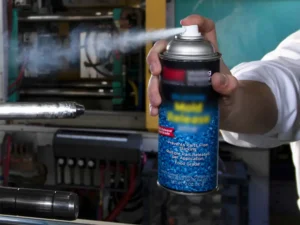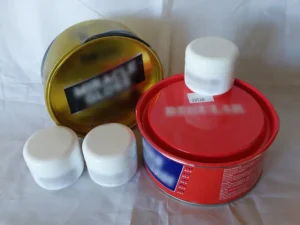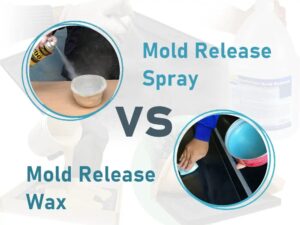Introduction:
Mold Release Spray and Mold Release Wax are both commonly used in various industries to facilitate the release of molded products from their molds. They serve as a barrier between the mold and the molded material, preventing adhesion and ensuring easy removal of the finished product.
While both products are designed to serve the same purpose, there are notable differences between them in terms of their application, properties, and advantages. This article will explore these distinctions to provide a comprehensive understanding of each product.
Mold Release Spray
Mold Release Spray is a liquid product sprayed onto the mold’s surface before the casting process begins. It is typically composed of lubricants, solvents, and release agents. The primary function of the spray is to prevent the material being cast from adhering to the mold surface.
When applied, it forms a thin and even layer on the mold surface. This layer acts as a barrier between the mold and the casting material. The lubricants in the spray reduce friction, making it easier for the casted object to be removed from the mold once it has cured or solidified. The release agents in the spray help prevent the casting material from sticking to the mold, ensuring clean and undamaged castings.
It offers several advantages. Firstly, it provides a quick and convenient application method, allowing even coverage on complex or intricate mold surfaces. The spray can reach areas challenging to reach with other application methods, such as brushes or cloths. Additionally, Mold Release Spray dries rapidly, reducing the waiting time before the molding process can commence. It is suitable for use with a wide range of materials, including plastics, rubber, composites, and various casting materials.
Mold Release Wax
Mold Release Wax, also known as Mold Release Paste or Mold Release Compound, is a semi-solid substance that is applied to the mold surface in a similar manner to the spray. It is typically made from a blend of waxes, oils, and sometimes silicone. It provides a smooth and slippery surface that facilitates the release of the casted object.
Mold Release Wax is spread evenly over the mold surface using a cloth or sponge. The wax fills in any imperfections or rough areas on the mold, creating a uniform and polished surface. This smooth surface helps prevent the casting material from sticking to the mold, enabling easy demolding once the cast has solidified.
It provides excellent release properties due to its low surface energy and lubricating properties. It creates a durable and long-lasting barrier between the mold and the molded material, ensuring multiple releases without needing reapplication. Moreover, wax can withstand high temperatures, making it suitable for use in molding processes that involve heat-cured materials.
Advantages and Disadvantages of Mold Release Spray VS Mold Release Wax
| Mold Release Spray | Mold Release Wax | |
| Advantages | – Easy and quick application | – Provides a smooth and polished surface |
| – Can be applied to complex mold shapes | – Fills in imperfections on the mold surface | |
| – Suitable for both small and large molds | – Offers long-lasting protection | |
| – Can be used on a variety of casting materials | ||
| Disadvantages | – Can be messy if over-sprayed | – Requires manual application |
| – May produce overspray in the surrounding area | – Requires occasional reapplication | |
| – Some formulations may have a strong odor | – May require buffing for optimal results | |
| – Limited reusability |
It’s important to note that the specific advantages and disadvantages may vary depending on the brand and formulation of the Mold Release Spray and Mold Release Wax being used. It’s always recommended to carefully read and follow the instructions provided by the manufacturer for the best results.
Differences between Mold Release Spray and Mold Release Wax
One of the primary differences between them lies in their application methods. Spray offers a quick and efficient way to apply the release agent onto the mold surface. It is ideal for situations where speed and convenience are crucial or when dealing with complex mold geometries.
In contrast, wax requires manual application, which can be time-consuming, especially for large or intricate molds. However, the manual application allows for precise control over the amount of wax applied and ensures complete coverage on the mold surface.
Another difference is the longevity of the release film. Sprays typically provide a temporary release effect, meaning that it needs to be reapplied before each molding cycle. In contrast, the wax type forms a more durable film that can withstand multiple releases without frequent reapplication. This characteristic makes wax a preferred choice for long production runs requiring continuous release.
Mold Release Spray or Mold Release Wax- Which one to choose?
Furthermore, the choice between spray and wax may depend on the specific molding process and materials used. The spray is generally compatible with various materials and molding techniques, including injection molding, rotational molding, and casting. It offers versatility and ease of use.
With its higher heat resistance, wax for mold release is particularly suited for applications involving high-temperature processes or heat-cured materials.
Conclusion:
In summary, Mold Release Spray and Mold Release Wax are both effective tools for facilitating the release of molded products from their molds. Spray offers quick and convenient application, suitable for various materials and molding processes. Wax, on the other hand, provides a durable and long-lasting release film, making it ideal for repeated releases and high-temperature applications.
The choice between the two depends on factors such as the specific molding process, the materials involved, and the desired durability of the release film. By understanding the differences between spray and wax agents, manufacturers can make informed decisions to optimize their molding operations and ensure efficient production processes.



